In 2018, ALMS received funding from the Lakeland Industry and Community Association (LICA), theRed Deer River Watershed Alliance, the Pigeon Lake Watershed Association, the MD of Wainwright,Jackfish Lake Management Association and Alberta Environment and Parks, to conduct LakeWatch, a volunteer based water quality monitoring program. Data presented below has not completed its final validation process.

Volunteers
In 2018, ALMS worked with 94 unique volunteers for a total of625 volunteer hours spent sampling lakes. Each year, ALMS recognizesone volunteer who has shown outstanding dedication and commitment to theLakeWatch program. This year, Anto Davis of Lacombe Lake was presented with the LakeWatch Volunteer of the Year Award.

Sample Record
Three summer field technicians (Alanna Roberts, Lindsay Boucher and Shona Derlukewich) were hired in May of 2018 to conduct water quality sampling. ALMS completed a provincial park monitoring program at five lakes and a standard monitoring program at 27 lakes. From June through early October 2018, lakes were visited four or five times each. In 2018, 142 of 149 scheduled trips were completed. This resulted in a completion rate of 95.1% (Table 1). Missed trips were a result of volunteer availability, one boat mechanical issue, and unsafe weather.
Table 1- The LakeWatch sample completion record for 2018.
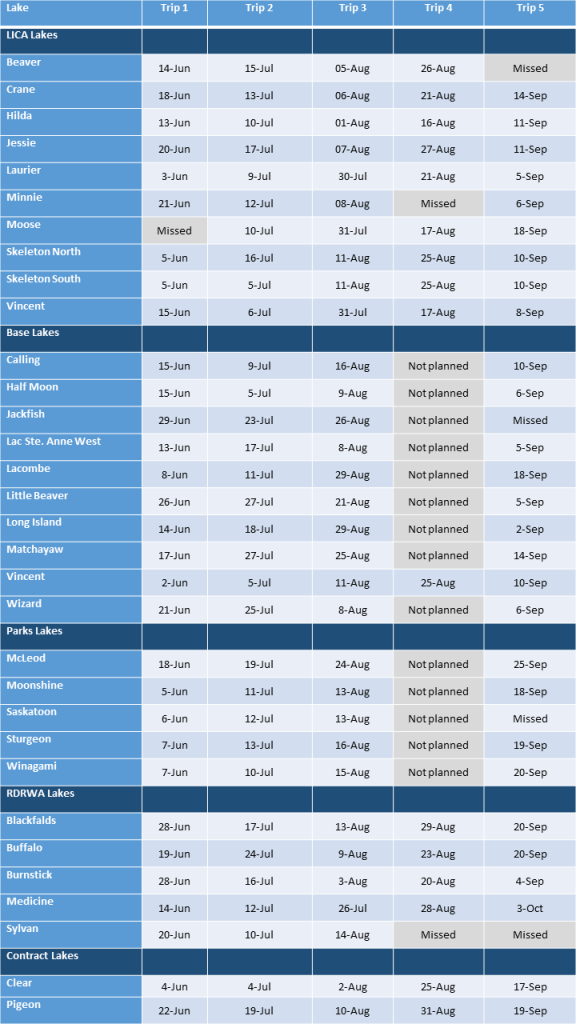
Results
While ALMS collects a large suite of water chemistry parameters, this report will highlight the variability which exists across only a few of our major parameters: Secchi Depth, Total Phosphorus, Chlorophyll-a, and Microcystin. The variation within these parameters does not necessarily reflect a degree of lake management, for many factors outside of human control also impact lake water quality. The depth of the lake, the size of the drainage basin, lake order, and the composition of bedrock and sediment are just some of the factors which affect lake water quality and should be taken into consideration when reading these results.
Water Clarity and Secchi Depth
Water clarity is influenced by suspended materials both living and dead,as well as dissolved colored compounds in the water column. During the melting of snow and ice in spring, lake water can become turbid (cloudy) from silt transported into the lake. Lake water usually clears in late spring but then becomes more turbid with increased algal growth as the summer progresses. The easiest and most widely used measure of lake water clarity is the Secchi disk depth. Two times the Secchi disk depth equals the euphotic depth – the depth to which there is enough light for photosynthesis.
Average Secchi depths in 2018 ranged from a minimum of 0.38 m at Half Moon Lake to a maximum of 4.98 m at Burnstick Lake (Figure 1). Water clarity at Half Moon,Little Beaver, Blackfalds and Saskatoon Lakes appears to be negatively impacted by algal blooms, and Secchi depth averages were significantly negatively correlated with average chlorophyll-a concentrations across lakes (Kendalls’ Tau-b, τb= -0.51, p-value < 0.001).

Water Chemistry
ALMS measures a suite of water chemistry parameters. Phosphorus, nitrogen, and chlorophyll-a are important because they are indicators of eutrophication, or excess nutrients, which can lead to harmful algal/cyano bacteria blooms. One direct measure of harmful cyanobacteria blooms are Microcystins, a common group of toxins produced by cyanobacteria.
Average total phosphorus concentrations ranged from a minimum of 1.2 µg/L at Clear Lake to a maximum of 1050 µg/L at Jessie Lake (Figure 3).
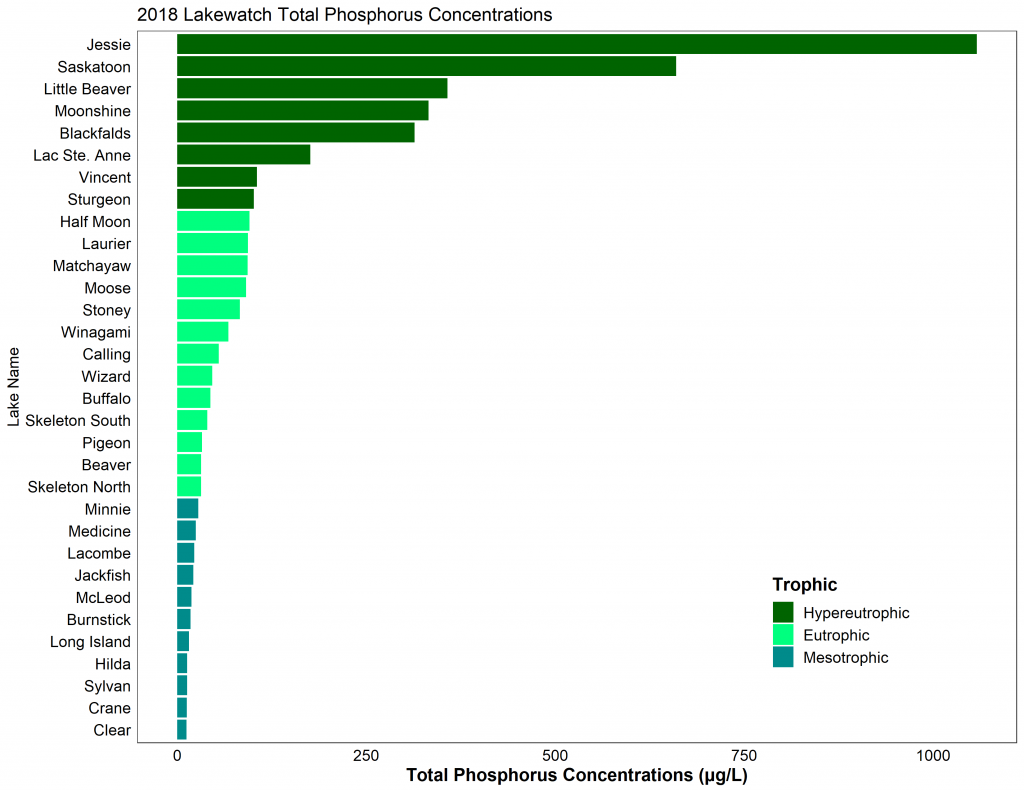
Chlorophyll-a
Chlorophyll-a is the green pigment found in plants and algae’s that allows them to photosynthesize. Measuring the concentration of chlorophyll-a is a common way of testing how much algae is present in lake water, because any green algae will contain it.
Average chlorophyll-a concentrations ranged from a minimum of 2.82 μg /L at Burnstick Lake to a maximum of 197 μg /Lat Little Beaver Lake (Figure 4).
Chlorophyll-a and TP averages were significantly correlated across lakes (Kendalls’ Tau, τ= 0.64,p-value < 0.001).

Microcystin
Microcystins are toxins produced by cyanobacteria (blue-green algae) which, when ingested, can cause severe liver damage. Microcystins are produced by many species of cyanobacteria which are common to Alberta’s Lakes, and are thought to be the one of the most common cyano bacteria toxins. In Alberta, recreational guidelines for microcystin are set at 20 µg/L.
Average microcystin concentrations fell below the minimum detection limit of 0.1 μg/L at Long Island Lake (Figure 5). Microcystin was detected at every other lake, with the highest average concentration observed at Little Beaver Lake, measuring 14.5 μg /L.None of the lakes sampled measured higher than the recreational guideline of 20μg /L at any time throughout the summer of 2018. However, samples from individual locations may display toxin concentrations higher than the recreational guidelines, and caution should be observed when recreating in or around cyanobacteria.
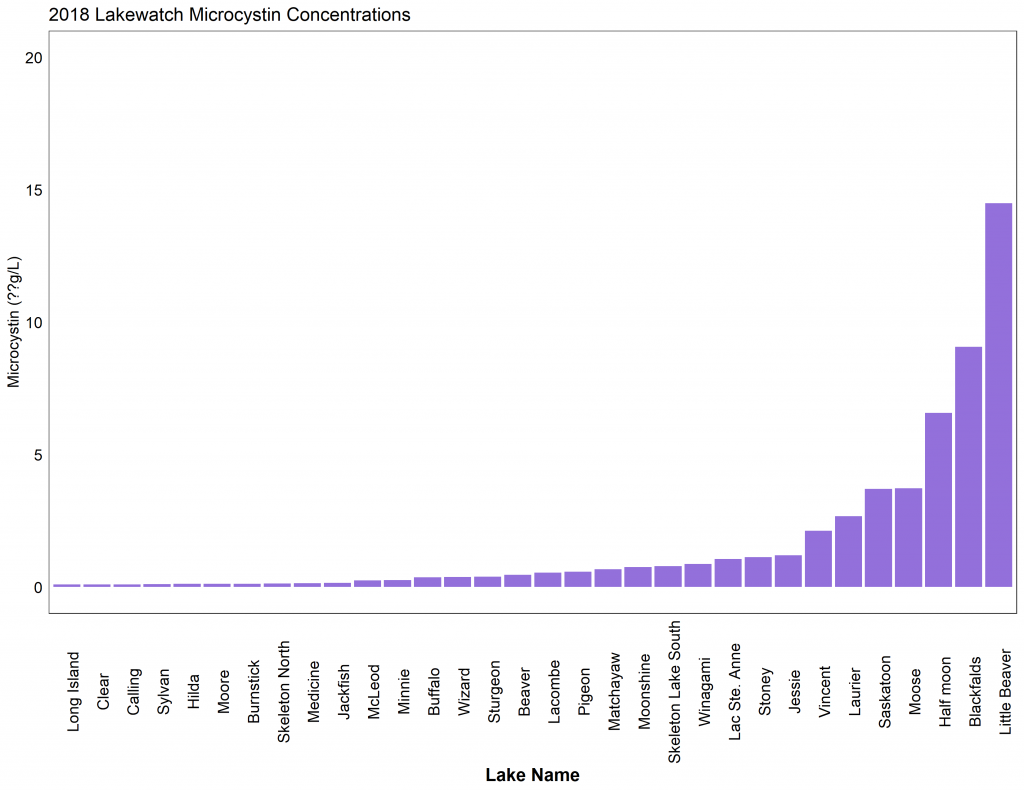



 The members of the steering committee will continue to play a strong role in facilitating and tracking implementation actions. This includes any actions they were responsible for, as well as tracking other committees and sector’s actions and progress made towards achieving the plan’s outcomes. Ongoing communication is essential to successful implementation and achieving outcomes, therefore a regular reporting mechanism could be set up in order to provide regular evaluation of the plan.
The members of the steering committee will continue to play a strong role in facilitating and tracking implementation actions. This includes any actions they were responsible for, as well as tracking other committees and sector’s actions and progress made towards achieving the plan’s outcomes. Ongoing communication is essential to successful implementation and achieving outcomes, therefore a regular reporting mechanism could be set up in order to provide regular evaluation of the plan.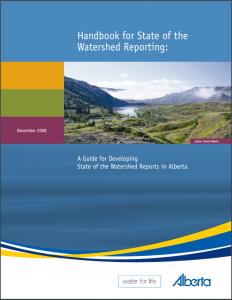

 Reporting is an essential component of any watershed management planning and implementation process. There are two main types of reporting that should be shared with stakeholders on a regular basis: implementation reporting & effectiveness reporting.
Reporting is an essential component of any watershed management planning and implementation process. There are two main types of reporting that should be shared with stakeholders on a regular basis: implementation reporting & effectiveness reporting. There is no limit to the number or types of lake management actions, but they typically fall into the categories on the right.
There is no limit to the number or types of lake management actions, but they typically fall into the categories on the right.

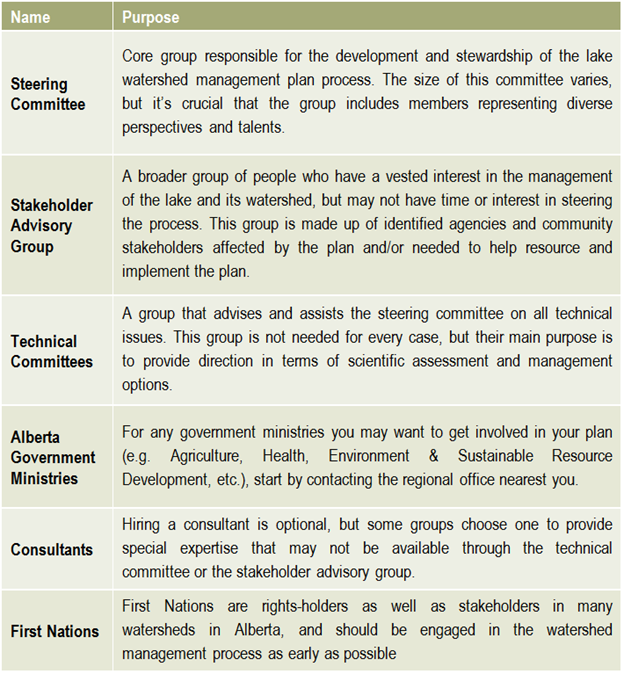 Helpful resources
Helpful resources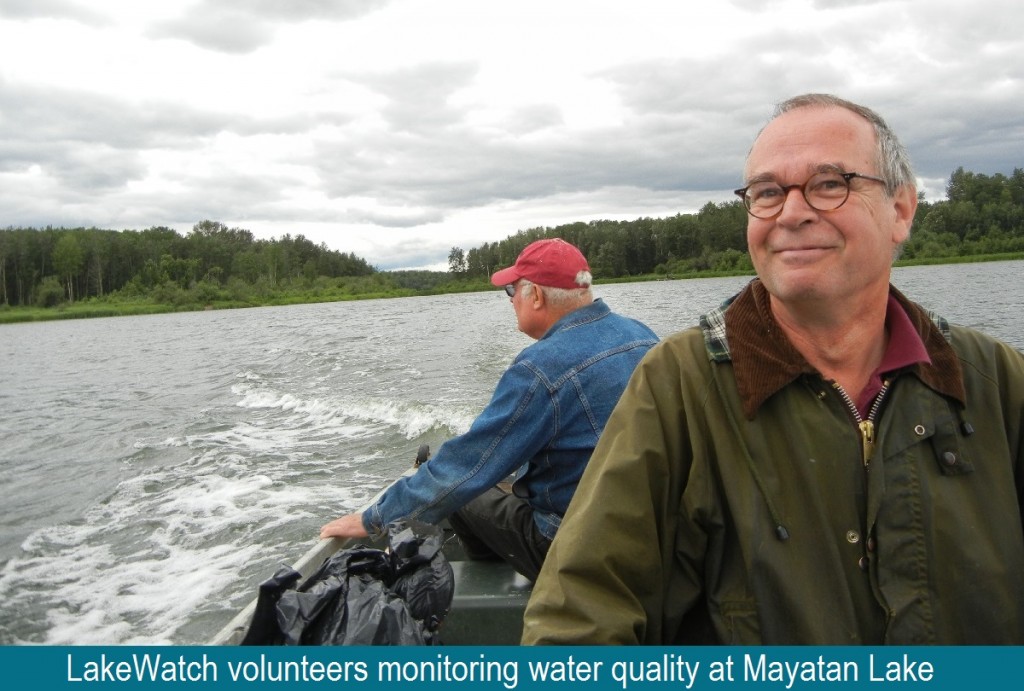 The development of a lake watershed management plan provides the guidance needed to implement activities, but the plan cannot be static. Monitoring the performance of your management actions is essential to understanding whether your goals have been met, and whether further actions are needed. Monitoring and evaluating the implementation and effectiveness of a lake watershed management plan allows assessment of progress towards the goals and objectives of the plan, identification of problems and opportunities, and a collection of critical information required when performing a 5 or 10 year review of the plan.
The development of a lake watershed management plan provides the guidance needed to implement activities, but the plan cannot be static. Monitoring the performance of your management actions is essential to understanding whether your goals have been met, and whether further actions are needed. Monitoring and evaluating the implementation and effectiveness of a lake watershed management plan allows assessment of progress towards the goals and objectives of the plan, identification of problems and opportunities, and a collection of critical information required when performing a 5 or 10 year review of the plan.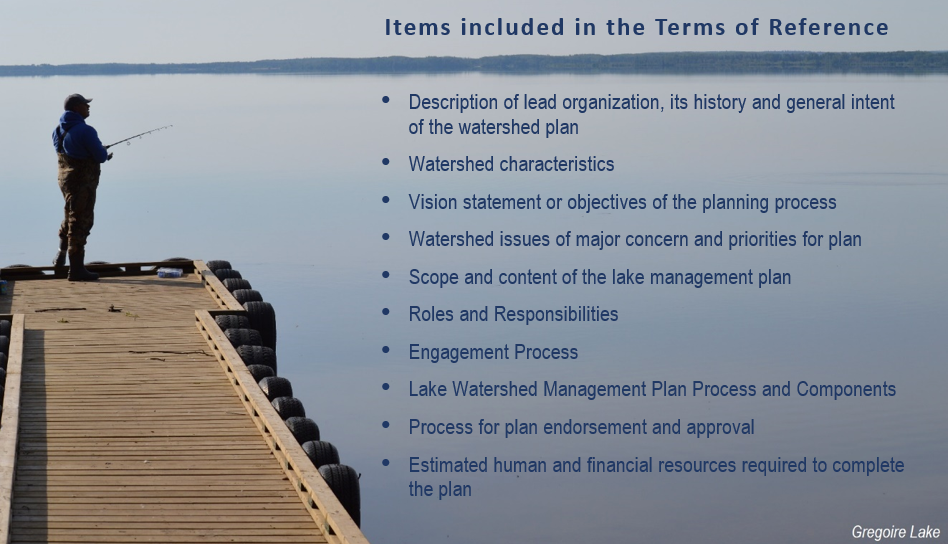
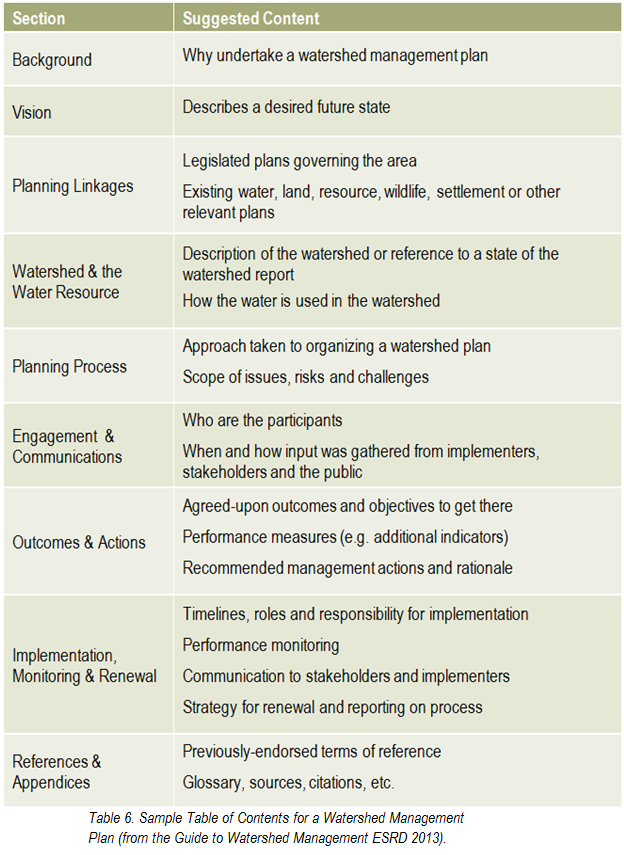
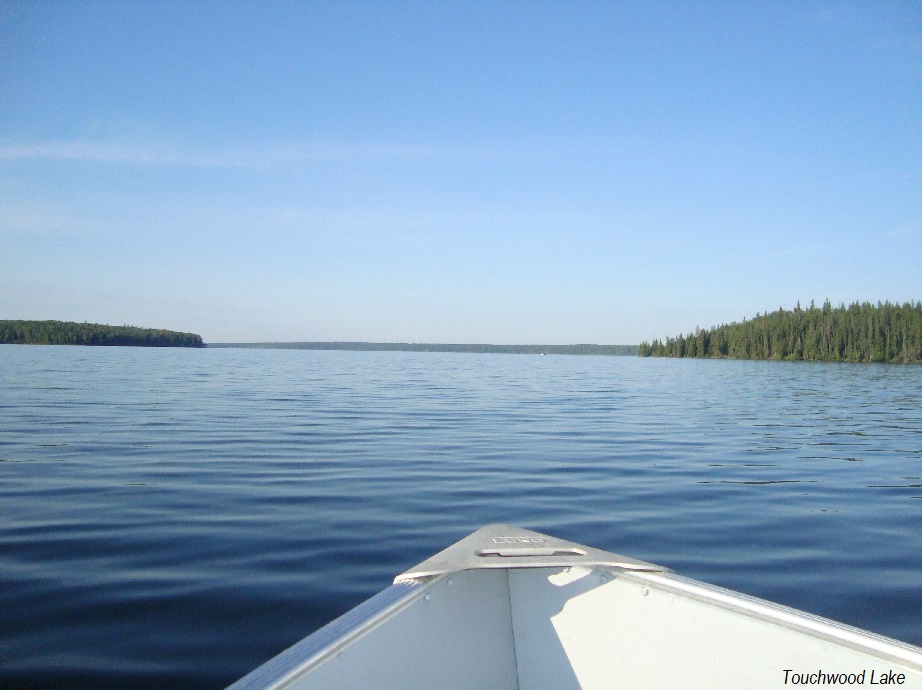 What has the monitoring results of the plan and of the indicators shown? Is there a need to modify the plan? It is important that the lake watershed management plan does not just sit on a shelf. Information gaps should be addressed, action items need to be managed, completed, and evaluated to best address the needs of the lake. Always keep in mind the vision: if the actions taken are not bringing the lake closer to that vision, then the plan needs to be modified. Consider updating both the state of the watershed and the lake watershed management plans at regular intervals to make sure that the actions taken were achieving the desired outcomes and to evaluate what work still needs to be done.
What has the monitoring results of the plan and of the indicators shown? Is there a need to modify the plan? It is important that the lake watershed management plan does not just sit on a shelf. Information gaps should be addressed, action items need to be managed, completed, and evaluated to best address the needs of the lake. Always keep in mind the vision: if the actions taken are not bringing the lake closer to that vision, then the plan needs to be modified. Consider updating both the state of the watershed and the lake watershed management plans at regular intervals to make sure that the actions taken were achieving the desired outcomes and to evaluate what work still needs to be done. Once a plan has been approved by all affected sectors and officially endorsed and released by the steering committee, then implementation can begin in full. Action projects can be large and comprehensive, or made smaller by staging projects over time or into modules that can be tackled one at a time. Fundraising is an issue that many community groups may find intimidating, but experience with programs such as the Pine Lake Restoration Program (see
Once a plan has been approved by all affected sectors and officially endorsed and released by the steering committee, then implementation can begin in full. Action projects can be large and comprehensive, or made smaller by staging projects over time or into modules that can be tackled one at a time. Fundraising is an issue that many community groups may find intimidating, but experience with programs such as the Pine Lake Restoration Program (see 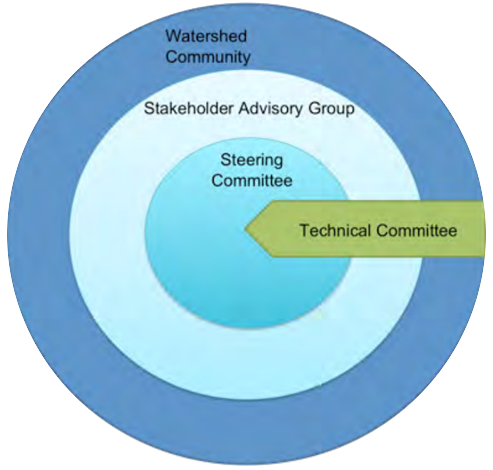 This graphic describes how the various committees and groups will work and interact together. The circle size depicts the approximate number of people involved, and the circles overlapping indicates that some individuals may reside in all of the circles and participate in multiple committees as part of the planning process. The technical committee is shown as an arrow, indicating that it is independent and has relatively few people, and yet it interacts with all of the groups. This graphic may look different depending on the lake and the people involved, and a detailed structure should be agreed upon and described in the plan’s Terms of Reference (Step 6).
This graphic describes how the various committees and groups will work and interact together. The circle size depicts the approximate number of people involved, and the circles overlapping indicates that some individuals may reside in all of the circles and participate in multiple committees as part of the planning process. The technical committee is shown as an arrow, indicating that it is independent and has relatively few people, and yet it interacts with all of the groups. This graphic may look different depending on the lake and the people involved, and a detailed structure should be agreed upon and described in the plan’s Terms of Reference (Step 6).
Recent Comments